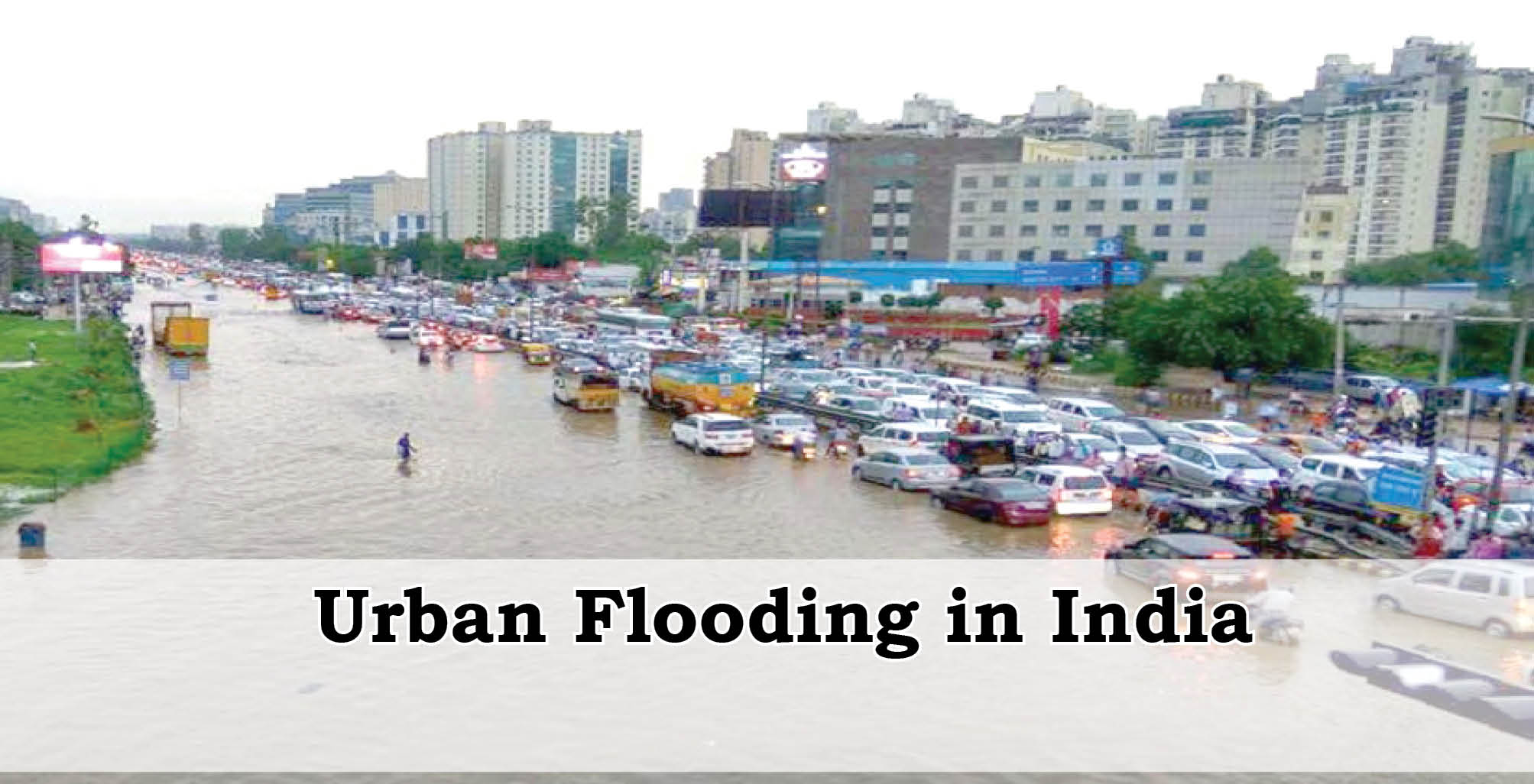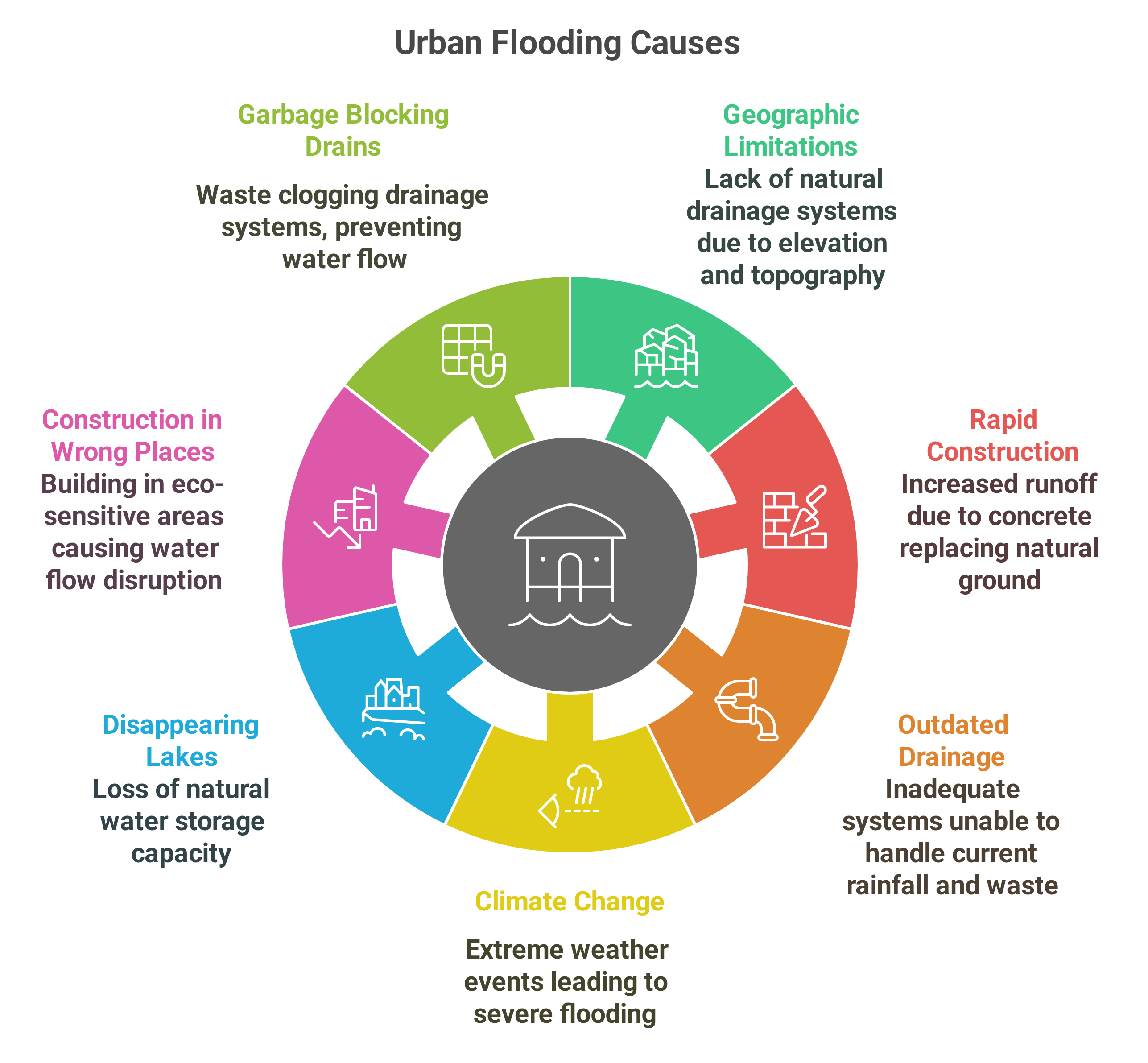Urban flooding has emerged as a serious concern for many Indian cities in recent years. With changing climate patterns, several parts of the country are now experiencing more frequent and intense rainfall events. In the 2025 monsoon season, many states received over 20% more rainfall than normal. While the rise in heavy rain is linked to climate change, the extent of flooding in urban areas is also shaped by local human activities. Poor land-use planning, rapid construction, shrinking green spaces, and outdated or inadequate drainage systems have made many cities more prone to waterlogging and flood-related damage.
- Bengaluru is one such city facing increasing flood risks. Despite being located at a higher elevation and historically having an extensive network of lakes and drains, it has seen repeated urban flooding in recent years. The pre-monsoon rains in May 2025 highlighted these vulnerabilities once again. In just 12 hours, the city received about 130 mm of rainfall, which overwhelmed existing infrastructure, flooded homes and roads, and caused serious disruptions. This incident underscores the need to rethink urban development strategies and strengthen disaster preparedness to cope with the growing threat of urban flooding.
About Urban Flooding:
Urban flooding happens when rainwater overwhelms a city’s drainage system, leading to waterlogging in streets, homes, and public spaces. Unlike floods in rural areas, which often happen near rivers or lakes, urban flooding is caused by too many concrete surfaces—like roads and buildings—that prevent rainwater from soaking into the ground. This causes the water to flow quickly over the surface, collecting in low-lying areas and blocking daily life. It can damage property, disrupt transport, and even create serious health risks.
Reasons Behind Urban Flooding:
· Geographic Limitations: Urban flooding stems from a combination of topographical and hydrological factors. Bengaluru, perched at an elevation of around 900 meters, lacks a major river system to drain excess water.
· Rapid Urban Construction: Rapid construction in cities has replaced natural ground with concrete. Since concrete can’t absorb water, rain quickly turns into surface runoff. In places like Mumbai, the built-up area has almost doubled in the past few decades, making flooding more likely with even moderate rainfall. Some city zones now generate nearly 30 times more runoff than natural landscapes.
· Outdated Drainage Systems: Many cities still use drainage systems that were built several decades ago. These old systems weren’t designed for today’s population or rainfall levels. They often get blocked by garbage and debris. Delhi, for example, still follows a drainage plan made in 1976—even though its population has more than quadrupled since then.
· Climate Change: Climate change is causing more extreme and unpredictable weather. Cities like Chennai have seen record-breaking rainfall—over 1,200 mm in a single month in 2015, leading to severe floods. Across central India, heavy rain events have tripled since the 1950s, and scientists expect this trend to continue.
· Disappearing Lakes and Wetlands: Natural water bodies like lakes and ponds used to store excess rainwater. But many of them have been filled in for construction. In 1800, Bengaluru had 1,452 water bodies capable of storing 35 TMC of water. Today, only about 190 lakes remain, many of which have been encroached upon.
· Construction in the Wrong Places: Building in eco-sensitive areas—like hillsides or riverbanks—has disturbed the natural flow of water. This can trigger landslides and worsen flooding. Areas like ST Bed Layout and Manyata Tech Park in Bengaluru are built on ecologically sensitive lakebeds or valley zones. In cities like Shimla and Dehradun, fast construction in hilly areas has made these regions more dangerous during storms. The 2013 floods in Kedarnath showed the high cost of building without considering the environment.
· Garbage Blocking the Drains: Solid waste and construction debris clog drains, especially during heavy rains. Improper garbage disposal is a big issue. Plastic waste and debris clog drains, stopping water from flowing out. Indian cities produce more than 1.5 lakh tonnes of waste every day, but only a fraction of it is properly treated. As drains fill with trash, even a short spell of rain can cause flooding.
Impacts of Urban Flooding:
· Loss of Life and Property: Recent floods in Bengaluru led to fatalities and large-scale property damage.
· Economic Disruptions: Shutdowns in tech corridors, like Bengaluru’s Outer Ring Road, impact national exports.
· Public Health Crisis: Stagnant water spreads vector-borne diseases and waterborne infections.
· Infrastructure Damage: Roads, metros, and power lines are rendered inoperative, compounding the crisis.
Solutions and Best Practices:
1. Institutional and Governance Reforms: States must enhance coordination between climate change and disaster management agencies. NDMA’s National Disaster Management Framework emphasizes preparedness, recovery, and reconstruction. Cities should establish interdepartmental Disaster Management Authorities with professional leadership.
2. Urban Planning and Resilience: Cities need to prepare contour maps and conduct detailed stormwater surveys. Implementing comprehensive stormwater management systems—such as the Brihanmumbai Stormwater Disposal System—is essential. Preventing new encroachments and removing existing obstructions to drainage networks must be prioritized. Additionally, banning plastics and regulating solid waste disposal are critical to improving urban water flow.
3. Central Government’s Role: The central government should support city financial health through infrastructure funding and incentivize smaller cities to reduce migration pressure on megacities.
4. Climate Action Plans (CAPs): Every city must draft and implement a CAP based on its specific vulnerabilities. Annual municipal budgets should allocate dedicated funds to CAP projects. Cities like Mumbai have already begun integrating urban floods into their broader climate strategies.
5. Nature-Based and Technological Solutions: Green infrastructure such as green roofs, permeable pavements, and urban wetlands must be promoted. Rooftop rainwater harvesting should be adopted on a large scale to reduce runoff. Infiltration beds can be installed on rooftops to compensate for lost soil permeability. Designating open areas as detention ponds for temporary water storage and building underground reservoirs—like Hong Kong’s Tai Hang Stormwater Storage Tank with a 100,000 m³ capacity—can further improve resilience. IoT-based monitoring systems using smart sensors can detect rising water levels and trigger timely alerts.
6. Global Innovations: International models offer valuable lessons. Singapore’s SWAN uses real-time water level sensors and predictive flood alerts. The Netherlands’ Room for the River initiative creates controlled flooding zones and expands river capacity. China’s Sponge Cities concept transforms urban surfaces to absorb and store rainfall. New Orleans has pioneered FLOAT Houses—floating homes that can adapt to rising waters.
Conclusion:
Urban flooding in India is a governance and planning crisis exacerbated by climate change. To avert future catastrophes, India must adopt a dual strategy: limit demographic pressure on large cities through national policies and invest in resilient infrastructure and governance reforms. Only by integrating climate resilience into the fabric of urban planning can Indian cities hope to manage the growing threat of urban floods effectively.
| Main question: "Urban flooding in India is as much a failure of planning as it is a result of climate change." Examine with reference to recent incidents in Indian cities. |








